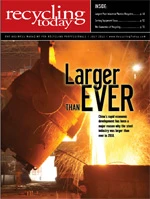 |
Steel mill buyers on the spot market in June returned to paying more than $500 per ton for prompt grades of ferrous scrap, as, after two months of declining in value, ferrous prices rebounded by about $15 per ton during the June buying period.
According to the Raw Material Data Aggregation Service (RMDAS) of Management Science Associates (MSA), Pittsburgh, the national average for its prompt industrial composite grade (No. 1 busheling, No. 1 bundles and No. 1 factory bundles) was $508 per ton during the June buying period.
The $15 hike in prompt grades nationally was joined by a $16 rise in prices paid for No. 2 shredded scrap and a $14 per ton increase in prices paid on the spot market for No. 1 heavy melting steel.
Pricing that remains at the upper end of its historic range has helped keep obsolete scrap flowing into scrap yards.
A scrap processor in the Western United States reports steady scale traffic throughout the spring months, with obsolete scrap continuing to make its way into his facility. “I don’t know where it’s coming from, but it just keeps showing up,” he says of his peddler traffic. “I don’t know if they’re going out farther to get it, but my tonnage is still good.”
“I don’t know where [the scrap] is coming from, but it just keeps showing up. I don’t know if [peddlers are] going out farther to get it, but my tonnage is still good.”
—Scrap recycler in the Western United States
The processor remarks that high nonferrous scrap pricing works hand-in-hand with lofty ferrous pricing to keep the obsolete scrap flow strong. “If they get a pickup truck load full of scrap, they bring it in.”
His concern lies not with the current reaction to scrap pricing but with what might happen to the obsolete scrap flow if or when prices return to a fraction of their current levels. Peddlers “may be getting spoiled” by the prices they’ve been enjoying recently and may devote their time to other odd jobs when prices drop, he says.
Steel mills in the U.S. held steady in their output in mid-June. The American Iron and Steel Institute reports that for the week ending June 11, 2011, raw steel production was 1.84 million tons, with a capability utilization rate of 75.3 percent.
That rate of production was up 0.6 percent from the previous week (ending June 4, 2011), when production was 1.83 million tons and the capability utilization rate was 74.8 percent.
Judging by numbers gathered for the first four months of 2011 by the U.S. Department of Commerce’s Census Bureau, the export market stands ready to absorb ferrous scrap shipments as well.
From January through April 2011, the value of ferrous scrap exported from the United States was $3.1 billion, which is a 43 percent increase in value from shipments in the first four months of 2010.
“Turkey’s largely electric-arc-furnace-based steel industry produced 13.5 million metric tons of steel in the first five months of 2011, a 23 percent leap compared with the 11 million metric tons it produced in the same period in 2010.”
Part of that increase can be explained by per-ton pricing that has been higher in 2011 than in 2010, but the increase in value has only been by about 25 percent.
The nation that has received the largest increase in scrap shipments from the United States (by value) in 2011 has been Turkey, which is likely because of an increased amount of ferrous scrap purchases.
Turkey’s largely electric-arc-furnace- (EAF-) based steel industry produced 13.5 million metric tons of steel in the first five months of 2011, a 23 percent leap compared with the 11 million metric tons it produced in the same period in 2010.
World crude steel production for May 2011 in the 64 countries reporting to the Brussels-based World Steel Association was 130 million metric tons. That output is up by more than 2 percent compared with the 127 million metric tons produced in April 2011.
China, the world’s leading steel producer, churned out 60.2 million metric tons in May, a figure higher than the 59 million tons the nation produced in April.
Japan saw a 7 percent decrease in it steel production, with 9 million metric tons of steel produced in May 2011. The decline was caused by the recent earthquake and tsunami. Production was up from April, however, when Japan churned out 8.4 million metric tons of steel.


Explore the July 2011 Issue
Check out more from this issue and find your next story to read.
Latest from Recycling Today
- P+PB adds new board members
- BlueScope, BHP & Rio Tinto select site for electric smelting furnace pilot plant
- Magnomer joins Canada Plastics Pact
- Out of touch with reality
- Electra names new CFO
- WM of Pennsylvania awarded RNG vehicle funding
- Nucor receives West Virginia funding assist
- Ferrous market ends 2024 in familiar rut





